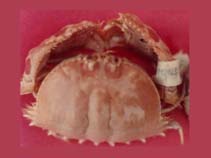Calappa philargius (Linnaeus, 1758)
Spectacled box crabWarning: DOMDocument::load(): SSL operation failed with code 1. OpenSSL Error messages: error:140770FC:SSL routines:SSL23_GET_SERVER_HELLO:unknown protocol in C:\Apache24\htdocs\includes\SpeciesSummary.lib.php on line 1236
Warning: DOMDocument::load(): Failed to enable crypto in C:\Apache24\htdocs\includes\SpeciesSummary.lib.php on line 1236
Warning: DOMDocument::load(https://sealifebase.nrm.se/webservice/AquaMaps/getAMap.php?genus=Calappa&species=philargius): failed to open stream: operation failed in C:\Apache24\htdocs\includes\SpeciesSummary.lib.php on line 1236
Warning: DOMDocument::load(): I/O warning : failed to load external entity "https://sealifebase.nrm.se/webservice/AquaMaps/getAMap.php?genus=Calappa&species=philargius" in C:\Apache24\htdocs\includes\SpeciesSummary.lib.php on line 1236
Classification / Names Common names | Synonyms | CoL | ITIS | WoRMS
| Decapoda | Calappidae
Environment: milieu / climate zone / depth range / distribution range Ökologie
; tiefenbereich 0 - 100 m (Ref. 343). Tropical
Verbreitung Länder | FAO Gebiete | Ecosystems | Vorkommen | Einführungen
Indo-Pacific.
Length at first maturity / Size / Gewicht / Alter
Maturity: Lm ? range ? - ? cm Max length : 12.0 cm CW Männchen/unbestimmt; (Ref. 343)
Kurzbeschreibung Morphologie
The two thick and strong chelipeds are similar in size. The movable fingers differ in forms and functions. Body is brownish-red, with distinct dark red spots on the chelae. A dark red ring is present around the eyes. Anterolateral margin of the carapace granulated. Posterolateral and posterior margins bear around 15 shape teeth.
Minimum depth from Ref. 99823. Subtidal (Ref. 106854). Occurs in sandy to slightly muddy substrates. Subtropical and tropical climates (Ref. 343). During the day, it buries itself, leaving only the eyes above the substratum. Forages as night. Feeds mainy on molluscs (Ref. 125532).
Life cycle and mating behavior Geschlechtsreife | Fortpflanzung | Ablaichen | Eier | Fecundity | Larven
Members of the order Decapoda are mostly gonochoric. Mating behavior: Precopulatory courtship ritual is common (through olfactory and tactile cues); usually indirect sperm transfer.
Hauptreferenz
Referenzen | Koordinator | Partner
Ng, P.K.L. 1998. (Ref. 343)
IUCN Rote Liste Status (Ref. 130435)
CITES Status (Ref. 108899)
Not Evaluated
CMS (Ref. 116361)
Not Evaluated
Bedrohung für Menschen
Harmless
Nutzung durch Menschen
| FishSource |
Tools
Mehr Information
Internet Quellen
BHL | BOLD Systems | CISTI | DiscoverLife | FAO(Publication : search) | Fishipedia | GenBank (Genom, nucleotide) | GloBI | Gomexsi | Google Books | Google Scholar | Google | PubMed | Tree of Life | Wikipedia (Gehe zu, Suchen) | Zoological Record
Estimates based on models
Preferred temperature
(Ref. 115969): 22.3 - 29.1, mean 28 (based on 1902 cells).
Preiskategorie
(Ref. 80766):
Unknown.



